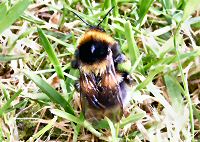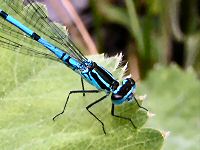There are more species of insects on earth than all other animals and plants put together. When you really look closely at the insects in the average garden, the variety is fantastic.
Living on a small densely populated island in the temperate northern hemisphere, we are not blessed with a spectacular array of 'wild animals' of the kind that normally get star billing on TV natural history programmes. Of course we have our few hundred species of birds, mammals amphibians and reptiles, some of which frequent our gardens, and for many people their appreciation of garden wildlife is limited to these species. That's a shame because virtually every garden in the UK is visited by
thousands of species of animal every year in the form of insects.
 A garden bumblebee (Bombus hortorum), distinguished by the two stripes in the middle of the body (one at the rear of the 'thorax' and one at the front of the 'abdomen').
A garden bumblebee (Bombus hortorum), distinguished by the two stripes in the middle of the body (one at the rear of the 'thorax' and one at the front of the 'abdomen').
For many people, insects are a closed book. I think there are several reasons for this: there is the 'fear' factor - sadly we often learn early that 'creepy crawlies' are 'nasty' and even as adults can find it hard to shake off this misconception; there is the obvious 'size problem' in that insects are smaller and less obvious than larger animals; finally there is also the difficulty of identifying what we see.
Curiosity and familiarity are normally all that is required to overcome our learned apprehension towards insects. As for the size problem, we have to look at the natural world around us with different eyes and to appreciate habitats at a different scale: when you develop the knack of doing this, the humble garden pond or bog garden seems as large and complex as a patch of Amazonian rain forest! I wouldn't trivialise these barriers by saying that they are
simple to overcome, indeed for some poor souls they may be insurmountable, but, as attitudes of mind, they are at least within the power of the individual to conquer. Identification is not so simple.
 A male common coenagrion (Coenagrion puella), distinguished from the common blue damselfly by the markings on the side of the thorax (in front of the wings) and the front of the abdomen (just behind the wings).
A male common coenagrion (Coenagrion puella), distinguished from the common blue damselfly by the markings on the side of the thorax (in front of the wings) and the front of the abdomen (just behind the wings).
Of course identifying the animals and plants we see is not
essential in order to enjoy them; but most people find that their enjoyment is hugely amplified if they know what they are looking at. It means that you can talk meaningfully about what you see with other people and also learn more about what your observation means from the literature. The best way to begin learning how to identify insects (as with any other group of animals or plants) is to obtain a good general guide which will help you to distinguish the most commonly seen species and groups. As you hone your skills and interests, you can obtain more specialist information on the animals which appeal to you.
Identification resources needn't always be expensive. My interest in bumblebees only really developed this year and that has largely been due to a free pullout 'pocket guide' that I got with an edition of the BBC Wildlife Magazine. Using this alone I have been able to identify (in my garden) all six species of common bumblebees likely to be encountered in the garden. Unable, with the help of my books alone, to decide whether the blue damselflies on my pond were common blue damselflies (
Enallagma cyathigerum) or common coenagrions (
Coenagrion puella) I resorted to the web and soon discovered their true identity.